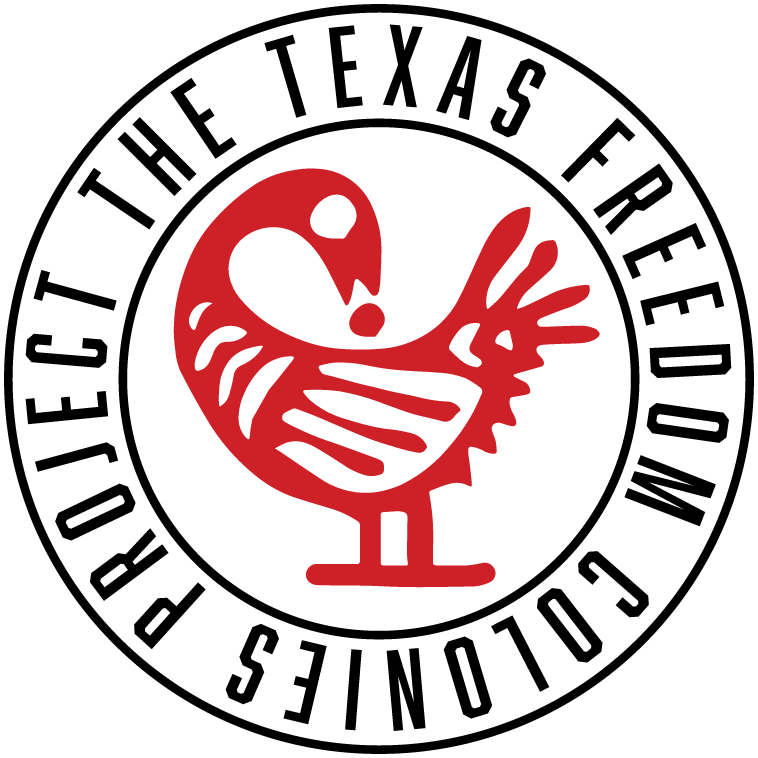What are Freedom Colonies?
Freedom Colonies are “historically significant communities” that were settled by formerly enslaved people during the Reconstruction and Jim Crow eras in Texas following Emancipation (Sitton, 2022). From 1865-1930, African Americans accumulated land and founded 557 historic black settlements. These Freedom Colonies were intentional communities created largely in response to political and economic repression by mainstream white society.

Freedom Colonies provided safe spaces where Black Texans could better avoid the perils of debt bondage, sharecropping, and racialized violence from white communities by living largely self-sustaining and independent lives on their own property (Sitton & Conrad, 2005). Since their founding, however, factors like gentrification, cultural erasure, natural disasters, resource extraction, population loss, urban renewal, and land dispossession have contributed to their decline—hundreds of settlements’ status and locations are currently unknown. Freedom Colony descendants’ lack of access to technical assistance, ecological and economic vulnerability, and invisibility in public records have quickened the disappearance of these historic Texas communities.
While the name “Freedom Colonies” applies uniquely to Texas settlements, Freedmen’s settlements were by no means solely a Texas phenomenon. After the Civil War, independent black communities emerged across the South. However, in the present day, Freedom Colonies find themselves in a distinct position when contrasted with their other black Southern counterparts. Many of the Freedmen’s settlements that receive scholarly or institutional attention

Freedom Colonies as Cultural Landscapes
A majority of known Freedom Colonies are located in the eastern half of Texas. The eastern half of the state contained a majority of the farmland and plantations on which the formerly enslaved once worked. Further, these coastal and flood-prone areas were some of the few areas in which African Americans could obtain land through adverse possession or squatting. In some rare cases, former plantation owners willed land to their Black offspring. Though originally concentrated in rural areas, Freedom Colonies also emerged on the edges of major cities. Due to urbanization and sprawl, many of today’s suburbs and major cities are founded atop Freedom Colonies. Common elements and characteristics of Texas Freedom Colonies’ cultural landscapes are their anchor institutions: schools, cemeteries, lodges, and churches. Of these elements, cemeteries and churches are the most persistent. Often several Freedom Colonies accessed the same churches and schools—for this reason, clusters of homesteads usually best define the Freedom Colony settlement pattern. Finally, the shared belief or knowledge of a community having once existed in a specific area is passed on through storytelling and commemorative events.
Freedom colonies are not, however, static landscapes; rather, they are active communities composed of dispersed yet committed social and kinship networks who return to preserve historic churches, homesteads, Rosenwald Schools, and cemeteries. Gatherings for festivals, funerals, church services, homecomings and family reunions serve as times for descendants of Freedom Colony founders to celebrate their successes and plan for the future of the settlements’ remaining extant features.
Identifying Freedom Colonies
A way to recognize or identify a Freedom Colony in a location would be to notice aspects of the natural landscape and the property types that remain as well as listen to residents define the borders, cultural landmarks, and names they ascribe to their own communities. Freedom Colonies would commonly be found in bottomlands and floodplains, which were areas whites found less desirable for land ownership. The land may be muddy, near a water source, and in a lower elevation than other surrounding communities would. Other characteristics to identify a colony would be to look at the remaining buildings and assess what they are/were as well as their time period of construction based on materials. A nearby cemetery or gravestones could also identify the evidence of a community; by looking at the names, dates, and inscriptions, the observer could learn when formerly enslaved people lived in a given Freedom Colony (Sitton & Conrad, 2005). Churches, particularly their cornerstones, provide helpful clues about local leaders and land-owning families. Cross-referencing these with county histories or personal archival data, like funeral and church anniversary programs, can reveal the names of settlements.
Cultural resource surveys, historical monographs, and academic theses are often the best written sources for information on Freedom Colonies

Vulnerable Communities
Texas Freedom Colonies have a variety of factors working against them and threatening their existence. These plots of land are often officially undocumented plots in the government’s eyes, so land ownership is a blurred line. Complex systems of inheritance and division of land lead to divided homesteads with unclear legal understanding of who owns what, where third party actors can purchase individual parcels that destroy the integrity of the community. Freedom Colonies are also vulnerable to being forgotten or undiscovered because most accounts of these colonies are from eyewitnesses and oral sharing, mostly by older generations of people, who are quickly disappearing or being forgotten. There is also the struggle to officially recognize these colonies through designation on the National Register of Historic Places, because there are often issues of defining the colonies within the official standards for designation. Another factor making these places vulnerable is their physical location, coupled with a lack of maintenance. With limited access to their rural locations and the hazards of being in flood plains, most physical evidence of these Freedom Colonies are being destroyed (Sitton & Conrad, 2005). There was also a turning point in Freedom Colonies during a decline in population after World War 2, due largely to the national trend of the Great Migration, violence, loss of building integrity, demolition, neglect, and red lining and segregationist zoning all over America (Texas Freedom Colonies).
Distribution of Freedom Colonies throughout the State
According to the Texas Freedom Colonies Project’s Atlas, there are 557 known place names. Of those 557 known communities, some 377 Freedom Colony locations have been

